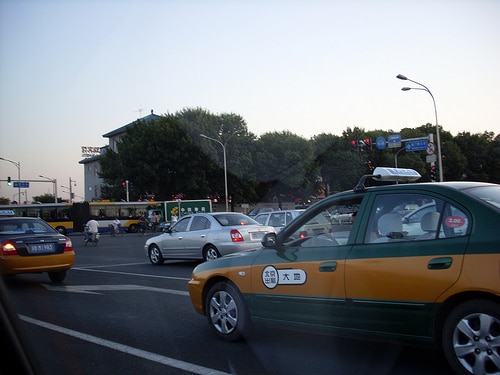When I was a child, my parents could easily get a cab in Beijing but now I have to stand for 30 minutes on the street desperately seeking available ones. At times, unoccupied cabs pass me by, but I know that I will probably be let down again, because passengers with “undesired” destinations are often dismissed by drivers for various reasons. The situation is even more horrendous during rush hour when cab drivers gather and rest by street sides or in parking lots at the time they are needed the most. Together with tens of thousands of passengers in Beijing, I had always been angry at these picky and unreliable cab drivers.
My stance changed when I chatted with some drivers and got to see the issue from the other side.
The cab drivers, as I was told, pay a monthly fee (“份钱” in Chinese) to their employers, and the rest of their earnings go to themselves. The traffic in Beijing is horrible with all the traffic jams, and in rush hour, the fare hardly covers even the gas, let alone the monthly fee. In order to cope with the monthly fee, some cab drivers share cars with each other through shifts. This requires that they deliver their cars to certain places at certain times of the day and cannot take every passenger they come across.
All of the 12 taxi companies in Beijing have the same high monthly fee. More than a decade ago, many taxi companies existed in Beijing along with independent taxi drivers. In 2000, when the Beijing government asked small companies to merge with big ones, only 12 big companies were left and independent drivers were banned. Rates stayed the same, cab drivers are paid the same, and safety problems were reduced. But the cab companies steadily raised the monthly fee while the fare for passengers hasn’t changed for 7 years. “That damn-high monthly fee really left us no option. We are innocent,” said one chatty cab driver I met.
While these cab drivers struggle with limited options, passengers are provided with more choices – pedicabs. These small cabs started to appear in every street corner. Their small size is not affected by the traffic jams and their availability beats the traditional taxis. With good bargaining skills (the tricycles are not yet regulated and have no meter), passengers sometimes even get cheaper prices.
Once I was saved by such a tricycle. I had to get to Sanlitun from Shimaotianjie in 20 minutes, and a tricycle cab rider let me in when she heard my destination and my bargain for the fare – 10 yuan. After 15 minutes of crazy journey on the road through forbidden shortcuts, I arrived safely and with five minutes to spare. I handed the old female rider 20-yuan in expect for change, but there was no such response.
“You agreed to the 10-yuan-fare. Now where is my change?” I asked.
“Who told you that I agreed to the 10 yuan fare? It should be 20, and you will get no change.” The motor rider claimed with confidence in a loud voice and asked me to “leave now.”
At that moment, I suddenly started to miss the regulated and metered taxis.


